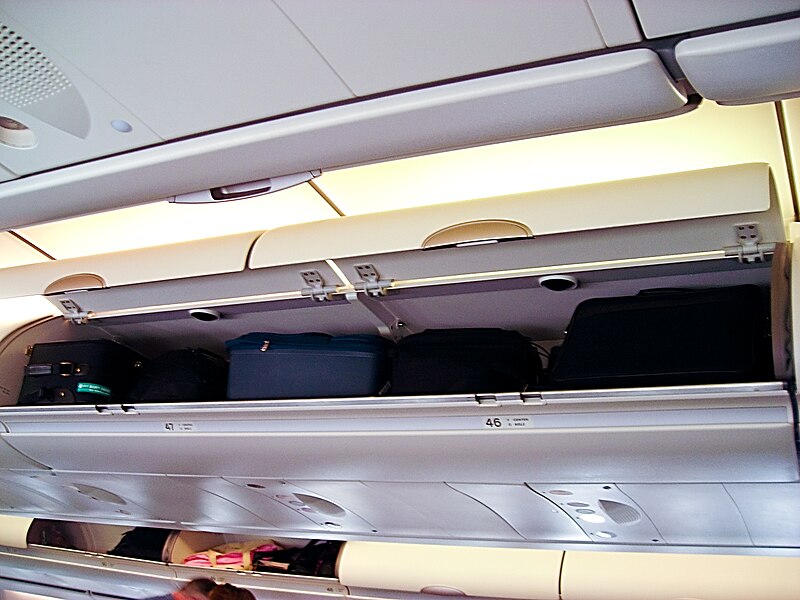New airline policies frequently raise feathers among flyers, but a recent policy change by Air Canada (TSX: AC.B) has everyday passengers divided into two camps of angry and understanding flyers. At the same time, the airline has its own reasons for measuring carry-on bags -- including some reasons you may not have thought of.
How has a new airline policy caused a split in passenger feelings? Could it be part of a broader trend?
Using the bag sizer
Depending on how you pack and where you travel, the bag sizers at airports may or may not be relevant to you in your travels. But these metal frames do have a purpose, and it's to quickly determine whether your carry-on bag meets airline size requirements.

Check-in at Halifax International Airport. A bag sizer can be seen near the right of this image. Source: Robert Alfers via Wikimedia Commons.
Although all carry-on bags should technically have to fit in the bag sizer, enforcement by airlines varies dramatically. Some carriers check every bag, while others completely ignore the bag sizer's presence.
This year, bag-size enforcement has been stepped up, with reports of increased checks at United Continental (NYSE: UAL) and American Airlines Group (AAL 1.50%). Even more recently, Air Canada joined the trend after enacting another separate policy (more on this later).
To fully examine this issue, let's look at all three viewpoints: passengers in favor of increased enforcement, passengers against increased enforcement, and the airlines themselves.
Airline perspective
For airlines, the two main reasons to tighten enforcement of carry-on bag sizes are increased efficiency and safety. Time is money in the airline industry; slower boarding increases time spent on the ground, decreases the number of flights an aircraft can operate each day, and leads to fewer on-time arrivals.

Air Canada Boeing 767 source: Wikimedia Commons
Airlines have sought out all sorts of different strategies to reduce boarding time, but carry-on bags, especially oversized ones, remain a problem. When passengers take the time to put a bag in the overhead bin, it adds to the time spent at the gate. With an entire planeload of passengers stowing luggage, this can really add up.
Oversized bags are an even bigger problem, because they clog the bins, forcing passengers to spend more time looking for space. Larger bags have a tougher time fitting through the aisles, slowing down overall movement.
Although it may not strike you as the main reason to check carry-on bag size more closely, passenger safety is an important consideration when it comes to carry-on bags. Statistics for carry-on bag injuries are difficult to obtain, but a widely cited estimate pegs the number at roughly 4,500 injuries per year, or about 12 per day. Many of these injuries are probably small in nature, but all of them are still best avoided.
When passengers are injured on board, the stories generate negative publicity for the airline, further delay boarding, and have the potential to cause legal problems for the airline. Not all carry-on bag injuries can be avoided, as some bags will inevitably be dropped as passengers lift them into overhead bins; but keeping bag size under control is a reasonable place to start.
Larger bags, which are often heavier, as well, are more difficult to control, and their greater weight increases the likelihood of injury when dropped or lifted. By cracking down on these bags, airlines can increase passenger safety through relatively simple means.
Passengers for the crackdown
Unlike many new airline policies, the crackdown on oversized carry-ons has the support of many passengers. These people cite reasons similar to the airlines, including increased safety, decreased boarding time, and less trouble in looking for overhead bin space.
Furthermore, not everyone pushes the limits of carry-on bag size, or even brings a bag on board, at all. For passengers packing light, the crackdown on oversized bags doesn't force them to change their habits; but it does free up more overhead bin space, decreases their chance of injury, and gets the plane off the ground more quickly.
Passengers against the crackdown
Of course, not everyone's happy with this stricter enforcement. Passengers who do test the size limits don't like having to pack lighter or check their bags. For these people, this crackdown is seen as too strict when existing bags that barely exceed the limits are forced to be checked.

Source: User:Mattes via Wikimedia Commons
Many in this group also feel that this stricter enforcement is just another way to get more money out of passengers. While carry-on bags on most carriers are free, checked bags rarely are, so every time a bag has to be checked, the airline makes a little more money.
Some travelers are also likely upset with the timing of Air Canada's carry-on crackdown coming just weeks after the airline announced it was introducing a fee on first-checked bags. It's tough to clearly determine whether these two events were placed so close together on purpose, but the timing will likely grab the attention of passengers anyway.
Too much baggage
The increased enforcement of carry-on bag sizes has split the passenger community while conveying clear benefits for airlines. Because this policy has many advantages for airlines, and the support of a fair number of flyers, I would not expect the carry-on crackdowns to end anytime soon.
When it comes to flying, it will serve you well to be aware of current policies, including this one -- enforced under the penalty of checked-bag fees.






